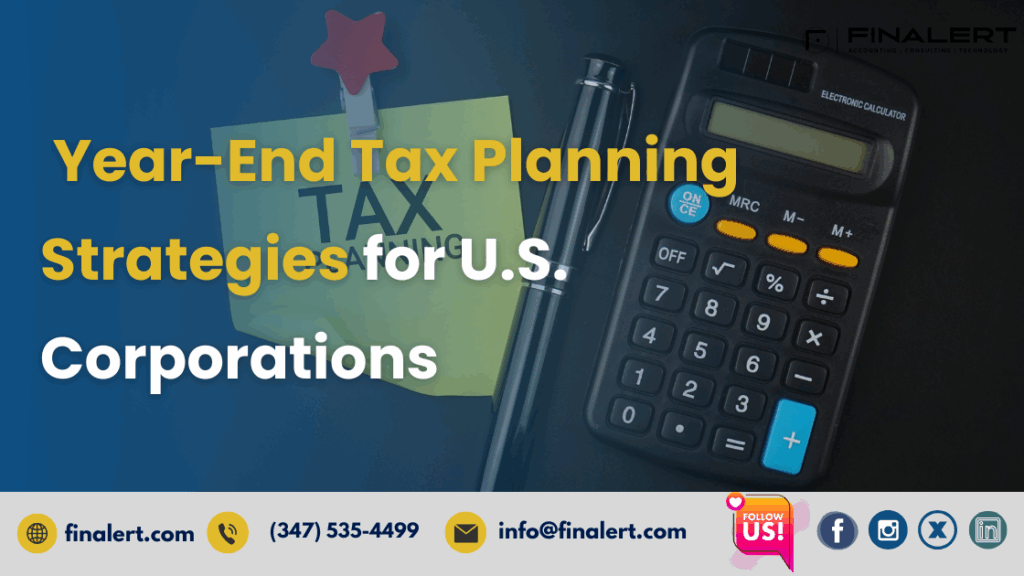
As the year draws to a close, U.S. corporations face a critical opportunity: strategic year-end tax planning. Far from being just a compliance task, tax planning is a forward-looking process that can significantly reduce tax liability, optimize cash flow, and position your company for success in the upcoming year.
In 2025, with evolving tax laws, shifting IRS enforcement priorities, and continued economic volatility, businesses can’t afford to leave tax planning until the last minute. This guide explores smart, actionable strategies U.S. corporations can implement before December 31 to take full advantage of available tax-saving opportunities and avoid surprises at filing time.
Effective year-end tax planning allows corporations to:
Whether your business is preparing for growth, reducing debt, or reinvesting profits, year-end tax strategy is essential for long-term financial health.
Timing is everything in tax planning.
Accelerate expenses if your business is having a profitable year and needs to reduce taxable income. Consider:
Defer income by:
This classic method allows businesses to shift taxable income into future years and bring deductions forward—maximizing the current-year tax advantage.
Capital expenditures made before year-end can significantly reduce your 2025 tax burden.
Use these provisions to write off the cost of significant investments rather than spreading the deduction over multiple years.
Many U.S. corporations miss out on valuable federal and state tax credits. Before year-end, review your eligibility for:
Be proactive in identifying these opportunities and gathering documentation before the year ends.
Your choice of business entity has direct tax implications. As the year ends, assess whether your current structure still supports your goals.
Changing your tax classification may not take effect until 2026, but now is the time to plan if restructuring is needed.

Corporate compensation decisions made in Q4 can significantly impact tax outcomes.
Also, assess payroll taxes and ensure that the compensation aligns with profitability and corporate goals.
Before closing the books, reconcile accounts and eliminate non-deductible or outdated entries. Focus on:
Removing these items now can result in a cleaner financial picture and a more favorable tax position.
If your corporation sponsors retirement plans, year-end is the ideal time to:
Contributions are generally deductible in the year they are made and are a great tool for both tax savings and employee retention.
If your corporation experienced a loss in prior years, you may be carrying Net Operating Losses (NOLs) forward to offset future taxable income.
Under current law:
Review your current-year profit and decide whether it’s wise to trigger income in 2025 to absorb existing NOLs, or defer income to preserve them.
Many corporations are surprised by year-end state or local tax bills. Review your:
Also assess whether electing Pass-Through Entity (PTE) tax in certain states (for S Corps or partnerships) could help circumvent the federal $10,000 SALT deduction cap.
Before wrapping up the year:
A well-documented file not only supports deductions and credits—it also minimizes audit risk.
Tax planning doesn’t end on December 31. Use this time to look ahead:
Taking the long view allows for smarter resource allocation and strategic planning across business functions.
Year-end tax planning is more than an exercise in financial housekeeping—it’s a strategic tool that every U.S. corporation should use to reduce risk, control costs, and plan for future success. By acting before December 31, businesses can take advantage of deductions, credits, and timing opportunities that will be lost once the calendar turns.
From optimizing depreciation and compensation to leveraging tax credits and streamlining financial records, proactive planning makes a measurable difference. With the right strategies in place and a tax advisor who understands your goals, you’ll enter the new year with clarity and control.
At Finalert, we help corporations navigate complex tax landscapes with precision and expertise. Our team specializes in identifying high-impact tax strategies tailored to your operations, growth goals, and industry specifics—so your business finishes strong and starts stronger.
Similar Articles
No results available
Get in touch with Finalert today for tailored business solutions!
No results available
Ready to thrive? Connect with Finalert today and let’s succeed together in the dynamic global market.
© 2025 Finalert. All rights reserved.
Ready to thrive in the dynamic global market? Finalert LLC offers expert financial services, including accounting, consulting, and technology solutions, tailored to your business needs.
Address
Accounting
Quick Links
Consulting
Industries
© 2025 Finalert LLC. All rights reserved.